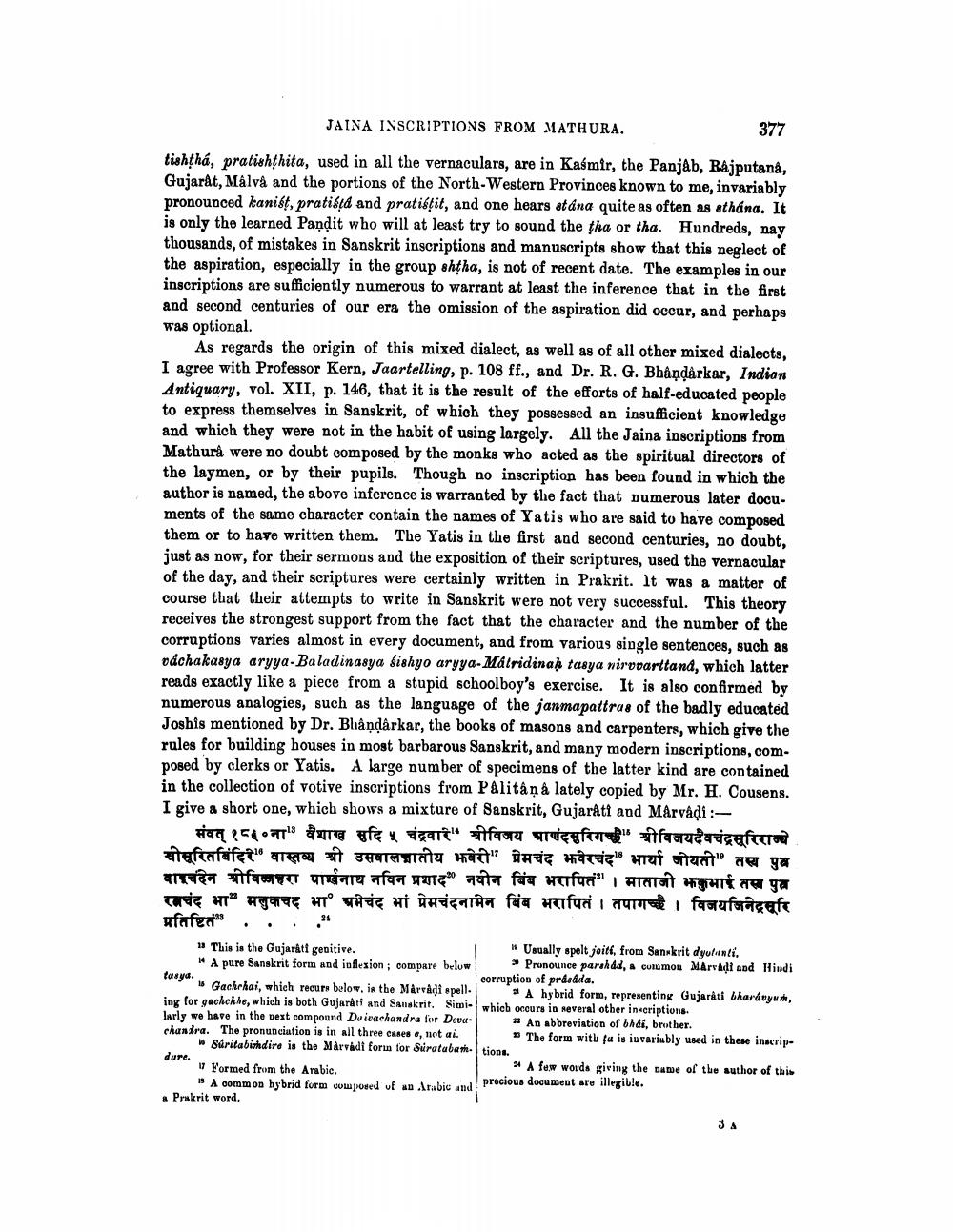________________
JAINA INSCRIPTIONS FROM MATHURA.
377
tishthá, pratishthita, used in all the vernaculars, are in Kasmir, the Panjab, Rajputana, Gujarat, Mâlva and the portions of the North-Western Provinces known to me, invariably pronounced kanist, pratiśd and pratiftit, and one hears stána quite as often as ethana. It is only the learned Pandit who will at least try to sound the tha or tha. Hundreds, nay thousands of mistakes in Sanskrit inscriptions and manuscripts show that this neglect of the aspiration, especially in the group shtha, is not of recent date. The examples in our inscriptions are sufficiently numerous to warrant at least the inference that in the first and second centuries of our era the omission of the aspiration did occur, and perhaps was optional.
As regards the origin of this mixed dialect, as well as of all other mixed dialects, I agree with Professor Kern, Jaartelling, p. 108 ff., and Dr. R. G. Bhåndarkar, Indian Antiquary, vol. XII, p. 146, that it is the result of the efforts of half-educated people to express themselves in Sanskrit, of which they possessed an insufficient knowledge and which they were not in the habit of using largely. All the Jaina inscriptions from Mathura were no doubt composed by the monks who acted as the spiritual directors of the laymen, or by their pupils. Though no inscription has been found in which the author is named, the above inference is warranted by the fact that numerous later documents of the same character contain the names of Yatis who are said to have composed them or to have written them. The Yatis in the first and second centuries, no doubt, just as now, for their sermons and the exposition of their scriptures, used the vernacular of the day, and their scriptures were certainly written in Prakrit. It was a matter of course that their attempts to write in Sanskrit were not very successful. This theory receives the strongest support from the fact that the character and the number of the corruptions varies almost in every document, and from various single sentences, such as váchakasya aryya-Baladinasya sishyo aryya-Mátridinaḥ tasya nirvoarttand, which latter reads exactly like a piece from a stupid schoolboy's exercise. It is also confirmed by numerous analogies, such as the language of the janmapattrae of the badly educated Joshis mentioned by Dr. Bhandarkar, the books of masons and carpenters, which give the rules for building houses in most barbarous Sanskrit, and many modern inscriptions, com. posed by clerks or Yatis. A large number of specimens of the latter kind are contained in the collection of votive inscriptions from Palitâņa lately copied by Mr. H. Cousens. I give a short one, which shows a mixture of Sanskrit, Gujarati and Marvadi :
संवत् १८६.ना' वैशाख सुदि ५ चंद्रवार" श्रीविजय पाणंदसुरिगच्छे" श्रीविजयदैवचंद्रसूरिराज्ये वीरितबिंदिरे वास्तव्य श्री उसवालजातीय झवेरी" प्रेमचंद झवेरचंद भार्या जोयती" तस्य पुब वाचंदन श्रीविनहरा पार्श्वनाथ नविन प्रशाद नवीन बिंब भरापित" । माताजी भकुभाई तस्त्र पुत्र
रखचंद भा" मलुकचद भा अभचंद भां प्रेमचंदनामेन बिंब भरापितं । तपागच्छ । विजयजिनेद्रसूरि wfafcat* . . . 24 1 This is the Gujarått genitive.
* Usually spelt joiti, from Sanskrit dyulunti. * A puro Sanskrit form and inflexion; compare below » Pronounce parohdd, culumou Marvadi and Hindi
corruption of prasada. Gachrhai, which recure below, is the Marvadi epell. A hybrid form, representing Gujarati bhardwywth, ing for gachchhe, which is both Gujarati and Sanskrit. Simi- which occurs in several other inscriptions larly we have in the text compound Duivachandra for Devu 11 An abbreviation of bdi, brother. chandra. The pronunciation is in all three cases, net ai.
The form with fu is invariably used in these inscripSaritabishdire is the Marvadi form for Siratabant. tions. dare. Formed from the Arabic.
94 A few words giving the name of the author of this 1 A common bybrid form composed of an Arabic and
precious document are illegille.
" # Prakrit word.




